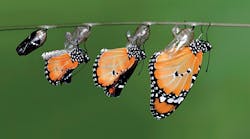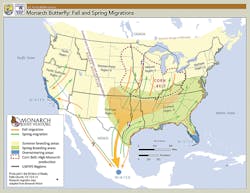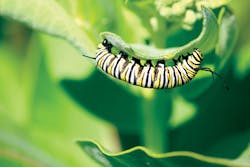To many people in Munfordville, Kentucky, Charlie Williams is simply known as the “tree man.” Over the years, he has added more than 1,000 acres of woodlands to his West Wind Farm. As he acquires land, he is reversing the impact of 200 years of prior timber management. Williams removes damaged or poor-quality trees to improve long-term woodland health. He enhances wildlife habitat by planting additional trees and establishing diverse grasslands on former tobacco fields. He also hosts numerous forestry field days for children and adults. Williams’ actions have earned him widespread recognition. In 2015, the tree man received the prestigious Leopold Conservation Award, presented by Sand County Foundation and partners.
In 2014, the Rural Electric Cooperative Corp. (RECC) needed to upgrade a transmission line crossing West Wind Farm to 69 kV. RECC needed to expand its easement width from 60 ft to 240 ft, requiring the clearing of mature trees. Williams saw this not as a threat but an opportunity. He asked RECC to allow his logger to remove the marketable timber first, to leave native understory trees like dogwood and redbud undisturbed, and to allow him to select the wildflower mix for reseeding. RECC agreed, and Williams made sure the seed mix included swamp milkweed to benefit monarch butterflies.
Williams’ attention to the monarch butterfly is particularly relevant to how vegetation in rights-of-way (ROW) are managed. The monarch is an iconic species, recognized by all. This species conducts a fascinating annual migration from wintering grounds in Mexico and California to much of the U.S. Monarchs require milkweed to reproduce, but modern agricultural practices and urban expansion have removed much of the breeding habitat on which monarchs depend.
In response to a petition, the U.S. Fish & Wildlife Service is now evaluating whether to list the species as threatened under the Endangered Species Act, a result that could alter vegetation management within utility ROW.
Higher Reliability in Healthy Habitats
Across the country, electric utilities work hard to clear ROW of any hazards to reliability. Typically, utilities ensure reliability by mowing on a four- to six-year cycle. This mechanical approach is expensive and damaging to beneficial plant and animal communities, and is often a source of aggravation in the community. Public concern over wildlife and other aspects of land management has prompted many utilities to seek out landowners as partners in a new approach to vegetation management.
Integrated vegetation management (IVM) of utility ROW accommodates milkweed and other flowering plants needed not only by monarchs, but also a broad array of pollinators crucial to agricultural production and ecosystem health. IVM promotes low-growing native plant communities of grasses, low-growing forbs and flowering shrubs compatible with ROW maintenance and operational needs. As it turns out, those plant communities most conducive to safe and reliable energy service also are just what pollinators and monarchs need.
IVM Success Stories
Several utilities are stepping up to the plate by trying IVM to improve the habitat and reduce vegetation management expenses. Multiyear studies on IVM demonstrate lower costs, improved reliability, environmental benefits and positive community responses.
The following examples make the case for the multiple benefits of IVM, including habitat enhancements for monarchs and pollinators:
• Dixie Electric Membership Corp. (DEMCO) is the largest electric cooperative in Louisiana, with more than 105,000 customers and more than 4,000 miles of line in seven southeast Louisiana parishes. In 1993, DEMCO adopted a systemwide IVM approach to ROW maintenance, including mechanical tree trimming, selective use of herbicides and natural control methods. DEMCO conducted an eight-year analysis of mechanical and herbicide application costs and outage rates, demonstrating significant cost reduction for vegetation management and an equally impressive reduction in outage hours of more than 70%.
ROW maintenance at DEMCO occurs on a circuit basis, first removing trees and woody invasive plants within the ROW, and then pruning trees located on the outer limits of the ROW. Shortly after the mechanical operation is performed, a selective herbicide is used at low volumes to prevent regrowth of unwanted tree and brush species that pose safety and reliability hazards. Native grass and wildflower seeds naturally present in the soil can then emerge and compete naturally with unwanted tree and brush species. The returning native growth provides a habitat for insect, mammal and reptile species.
• The Southern Minnesota Municipal Power Agency (SMMPA) provides generation and joint action services to 18 municipal utilities in southern Minnesota. Working with the Sand County Foundation, SMMPA is designing a program to support monarch butterfly conservation. This effort will raise public awareness in the agency’s member communities, and key state and federal stakeholders will partner to demonstrate the effectiveness of voluntary action to promote conservation. The multiyear SMMPA program will provide native wildflower seeds and milkweed plugs along with planting and maintenance instructions.
The first tier of the program will establish monarch waystations on properties owned by SMMPA and its members. The second tier will establish waystations on higher-visibility public-owned sites in parks, nature centers and schools. The third tier will provide free pollinator habitat seed packets to member utilities for distribution in their member communities.
• Carroll Electric Cooperative in Arkansas engaged an engineering consultant to analyze the costs of an IVM plan incorporating herbicides, as compared to a mechanical-only plan. This study estimated the net present value to the cooperative by adopting IVM would be in the range of $50 million to $70 million. The detailed study also showed a reduction in system outages and extraordinary expenses associated with major outage events. It concluded a systematic IVM approach has “proven to be the most effective means to provide a cost-effective approach in maintaining utility easement areas for safe and reliable electric service.”
• Great River Energy (GRE) in Minnesota seeks out opportunities for creating and maintaining native and pollinator-friendly habitat through partnerships. These partnerships have resulted in the establishment of pollinator habitat along electric ROW in the city of Ramsey’s Alpine Park, in conjunction with a renewable energy project at the Wolf Ridge Environmental Center and at the GRE headquarters complex in Maple Grove.
• Pacific Gas & Electric Co. (PG&E) in California is at the forefront of efforts to recover the western U.S.’s monarch population and pollinators vital to western agriculture. With nearly 20,000 miles of electric transmission corridor, PG&E is well positioned to support this goal. The utility has been working with the Pollinator Partnership, the Utility Arborist Association (UAA), the Sacramento Municipal Utility District and other stakeholders to implement research on the potential long-term impact of IVM on plant and wildlife communities.
The flagship project in this collaboration is the American River Parkway Pollinator Partnership Project, the first long-term comparative monitoring field study in the West to examine pollinator communities on actively managed ROW. The project attempts to control nonnative, invasive plants and favor creation of low-growing native plant communities along a ROW bisecting a public recreation landscape. In the study, the utilities are comparing the impact of standard mowing activities to selective herbicide use and other IVM techniques to address vegetation height, fuel loading and invasive weed issues. The results show an almost threefold increase in native bee abundance and a twofold increase in native bee species richness.
In another study, Sonoma State University students are comparing pollinator presence within another PG&E-managed electric transmission ROW. Preliminary research results indicate significantly higher pollinator use in the IVM ROW when compared to either the adjacent enclosed forest canopy or the adjacent unmanaged meadow.
Accordingly, PG&E is building on these positive results and expanding research partnerships. This includes providing $250,000 to the UAA to study the impacts and costs of IVM on utility ROW in California and other areas of the western U.S. A key focus will be on developing best practices that support pollinators and the recovery of the western monarch population.
Hailing this collaboration, Laurie Davies Adams, executive director of the Pollinator Partnership, said, “The need for multiple-purpose landscapes has never been greater, and the efforts that PG&E and the Pollinator Partnership have pioneered will bring tangible improvements in ecosystem services from pollinators, the impact of which can be felt in agricultural and wildland sustainability and health. From this visionary first step, landscapes will blossom into habitat without sacrificing the efficient, safe and reliable delivery of power.”
Where IVM Makes Sense
The introduction of a ROW maintenance plan with a new look may raise questions from ROW landowners, neighbors and community groups. While mechanical vegetation management often generates heated objections, an IVM approach creates other issues that must be addressed to support a successful outcome. The utility needs to be well prepared to discuss the new process with landowners and neighbors prior to implementation. Seeking out allies in the academic and natural resource communities can be a big help. Most utilities report some initial negative reactions to a change in a ROW maintenance technique, but over time, positive responses to an increase in naturalized ROW.
Utilities considering an IVM approach can turn to the UAA, state and federal regulatory and resource agencies, and vegetation management contractors for help. The transition to IVM following mechanical mowing allows a multiyear learning curve and smooths out the financial transition.
Utility converts will discover IVM improves system reliability, lowers costs and makes ROW safer for utility crews and the public. IVM practices also can provide significant environmental and conservation benefits from which the utility and the community will benefit — a point well illustrated in the example of Charlie Williams and the monarch butterfly.
According to Chip Taylor, a Kansas University professor and Monarch Watch founder, millions of acres of land are not needed for pollinator and monarch butterfly habitat. What is needed are millions of small patches of habitat along the thousands of miles of flyways. In other words, utilities need not restore habitat on all acres under their influence, but rather on a collection of strategic locations within ROW and adjacent to power plants, substations and offices across the nation.
Neil Palmer is a consultant working with the Sand County Foundation to facilitate the participation of electric generation, transmission and distribution utilities in the Sand County Foundation pollinator conservation program. He has 40 years of experience working for and with utilities on facility siting, permitting, construction and operations, and he is a member of the Utility Arborist Association.






